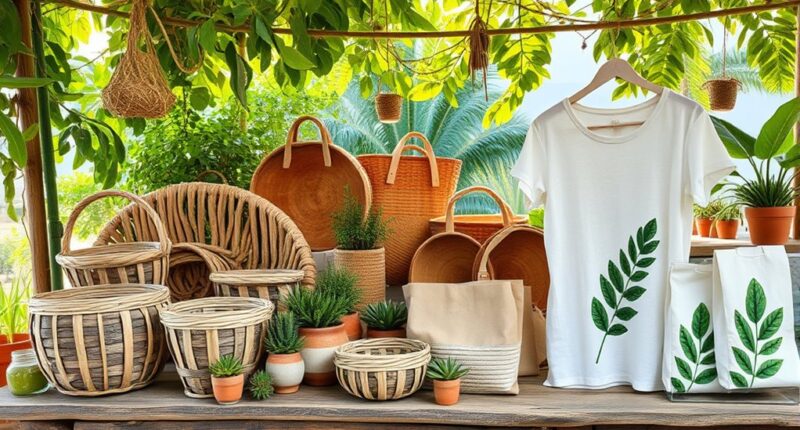To make eco-friendly merchandise, start by choosing sustainable materials like organic cotton, recycled plastics, bamboo, or hemp. Guarantee your supply chain practices ethical sourcing by looking for Fair Trade, B Corporation, or Rainforest Alliance certifications. Focus on environmentally conscious manufacturing processes and promote fair labor practices. Making smarter choices about materials and sourcing helps reduce environmental harm and supports social responsibility. If you keep exploring, you’ll discover how to create stylish, ethical products that make a real difference.
Key Takeaways
- Choose sustainable materials like organic cotton, recycled plastics, bamboo, or hemp for manufacturing your merchandise.
- Source materials ethically by selecting suppliers with fair labor practices and eco-certifications such as Fair Trade or Rainforest Alliance.
- Implement environmentally conscious production processes that minimize water, energy, and chemical use.
- Design products that are durable, reusable, and recyclable to promote a circular economy.
- Communicate your eco-friendly efforts and certifications to consumers to encourage mindful purchasing decisions.

Are you looking for ways to reduce your environmental impact while still enjoying everyday products? One of the best steps you can take is to focus on the materials used in the merchandise you choose. Opting for sustainable materials makes a significant difference, as these materials are sourced and produced with minimal environmental harm. Think about items made from organic cotton, recycled plastics, bamboo, or hemp. These options typically require less water, fewer chemicals, and less energy to produce compared to conventional materials. Not only do they lower your carbon footprint, but they also support a more circular economy by making use of recycled and renewable resources. When selecting products, always check if they’re made from sustainable materials, and prefer brands that prioritize transparency about their sourcing practices. Incorporating sustainable materials into your choices can also encourage innovation and the development of new eco-friendly products in the marketplace.
Alongside sustainable materials, ethical sourcing plays an essential role in creating eco-friendly merchandise. Ethical sourcing means that the products are obtained in a way that respects both the environment and the communities involved in production. It involves fair wages, safe working conditions, and environmentally conscious manufacturing processes. When you buy from brands committed to ethical sourcing, you help promote fair labor practices and reduce exploitation. This ensures that the production of your merchandise doesn’t come at the expense of workers’ well-being or ecological health. Look for certifications like Fair Trade, B Corporation, or Rainforest Alliance, which verify that the products meet high ethical standards. These labels give you confidence that your purchase supports responsible practices throughout the supply chain.
Incorporating sustainable materials and ethical sourcing into your choices doesn’t mean sacrificing quality or style. Many brands now produce trendy, durable, and functional products that are also eco-friendly. It’s about being mindful and intentional with your purchases—asking questions about where your products come from and how they’re made. By doing so, you influence the market to prioritize sustainability and fairness, encouraging more companies to adopt eco-conscious practices. Remember, small choices add up. Every time you select merchandise made from sustainable materials and sourced ethically, you contribute to reducing environmental harm and promoting social responsibility. Your conscious decisions can drive a shift toward a greener, fairer economy, making a tangible difference for the planet and its people.
Frequently Asked Questions
What Are the Most Sustainable Materials for Eco-Friendly Merchandise?
You should choose sustainable fabrics like organic cotton, hemp, or bamboo for eco-friendly merchandise. These materials are renewable, biodegradable, and require less water and chemicals. Pair your products with eco-conscious packaging, such as recycled or biodegradable materials, to reduce waste. By selecting sustainable fabrics and eco-conscious packaging, you demonstrate your commitment to environmental responsibility, helping you create merchandise that’s both appealing and environmentally friendly.
How Can I Verify the Eco-Friendliness of My Suppliers?
Think of yourself as a detective seeking the truth, just like Sherlock Holmes. To verify your supplier’s eco-friendliness, check their certification standards and demand proof of compliance. Look for transparent practices, asking for detailed information about their sourcing, manufacturing, and environmental policies. Trustworthy suppliers willingly share this data, so guarantee their transparency aligns with industry standards. This way, you confidently support genuinely sustainable partners.
Are Biodegradable Products Durable Enough for Regular Use?
Biodegradable products can be durable enough for regular use, but it depends on their eco product longevity and how you care for them. Look for items made from high-quality biodegradable materials that offer good biodegradable durability. Proper handling and maintenance can extend their lifespan, ensuring they remain functional over time. Keep in mind that some biodegradable products are designed specifically for short-term use, so choose those suited for your needs.
What Are Cost-Effective Options for Small Businesses?
Like Robin Hood’s clever choices, you can save money by opting for recyclable packaging and digital branding. These options reduce costs while boosting your eco-friendly image. Recyclable packaging is affordable and appealing to conscious consumers, and digital branding minimizes printing expenses. You’ll make a positive impact on the environment and your budget, proving that small businesses can be both sustainable and cost-effective with smart, eco-friendly solutions.
How Do Eco-Friendly Products Impact Brand Perception?
Eco-friendly products boost your brand perception by demonstrating your commitment to sustainability, which builds consumer trust. When you maintain branding consistency across eco-friendly merchandise, customers see your dedication to environmental values, making your brand more authentic and reliable. This positive perception encourages loyalty and attracts eco-conscious consumers, ultimately strengthening your reputation. By aligning your products with your brand’s core values, you foster a deeper connection, enhancing overall brand perception and trust.
Conclusion
By choosing sustainable materials, supporting ethical practices, and promoting eco-conscious values, you create merchandise that benefits the planet, supports communities, and inspires change. When you prioritize eco-friendliness, you reduce waste, conserve resources, and foster awareness. When you make mindful choices, you set an example, influence others, and contribute to a healthier world. By making eco-friendly merchandise, you turn your passion into action, your ideas into impact, and your efforts into a greener, more sustainable future.









